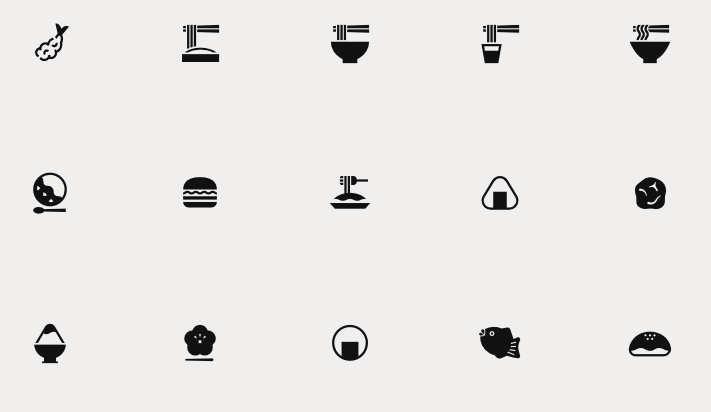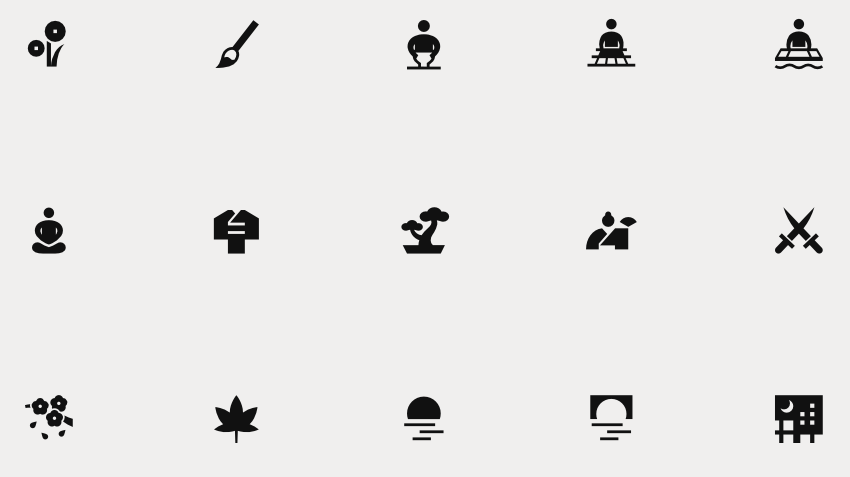[Most Recent Entries] [Calendar View]
Friday, February 26th, 2021
| Time | Event |
| 9:00a | Download 280 Pictographs That Put Japanese Culture Into a New Visual Language: They’re Free for the Public to Use
“One of the biggest considerations when traveling to Japan is its inscrutable language,” writes Designboom’s Juliana Neira. But then, one might also consider making that language more scrutable — and making one’s experience in Japan much richer — by learning some of it. Kanji, the Chinese characters used in the written Japanese language, may at first look like small, often bewilderingly complex pictures, and many assume they visually evoke the meanings they express. In fact, to use the linguistic terms, they’re not pictograms, representations of thoughts or ideas, but logograms, representations of words or parts of words.
Resemble miniature works of art though they often do, kanji aren’t entirely unsystematic. This helps beginning learners get a handle on the first and most essential characters of the thousands they’ll eventually need to know. So does the fact that some of them, in origin, really are pictographic — that is, they look like the meaning of the word they represent — or at least pictographic enough to make them teachable through images. The Japanese word for “mountain,” to cite an elementary example, is ?; “river” is ?; “tree” is ?. Alas, most of us who enjoy the ?, ?, and ? of Japan — to say nothing of the ?? and ??? in its cities — haven’t been able to visit them at all in this past pandemic year.
“After experiencing years of tourism growth, tourists to Japan are down over 95% due to the pandemic,” writes Spoon & Tamago’s Johnny Waldman. “Graphic designer Kenya Hara and his firm Nippon Design Center have self-initiated a project to release over 250 pictograms — free for anyone to use — in support of tourism in Japan from a visual design perspective.” Collectively bannered the Experience Japan Pictograms, these clear and evocative icons represent a wide range of the places and activities one can enjoy in the Land of the Rising Sun: skiing and surfing, calligraphy and open-air hot-spring bathing, Ginza and Asakusa, Tokyo’s Skytree and Osaka’s Ts?tenkaku Tower.
The Experience Japan Pictograms hardly fail to include the glories of Japanese cuisine — sushi, tempura, soba, and even the Japanified hanb?g? — which piques so many foreigners’ interest in Japan to begin with. Click on any of them and you’ll see a brief cultural and historical explanation of the item, activity, place, or concept in question, along with the relevant Japanese term (in kanji where applicable) and its pronunciation. You can also download them in the color scheme of your choice and use them for any purposes you like, including commercial ones. The more widely adopted they are, the more convenient Japanese tourism will become for those who don’t read Japanese. Those who do can hardly deny the pleasure of having another Japanese language to learn — and a truly pictographic one at that. via Spoon & Tamago Related Content: Vintage 1930s Japanese Posters Artistically Market the Wonders of Travel The Hobo Code: An Introduction to the Hieroglyphic Language of Early 1900s Train-Hoppers Google Makes Available 750 Icons for Designers & Developers: All Open Source Braille Neue: A New Version of Braille That Can Be Simultaneously Read by the Sighted and the Blind Based in Seoul, Colin Marshall writes and broadcasts on cities, language, and culture. His projects include the Substack newsletter Books on Cities, the book The Stateless City: a Walk through 21st-Century Los Angeles and the video series The City in Cinema. Follow him on Twitter at @colinmarshall or on Facebook. Download 280 Pictographs That Put Japanese Culture Into a New Visual Language: They’re Free for the Public to Use is a post from: Open Culture. Follow us on Facebook, Twitter, and Google Plus, or get our Daily Email. And don't miss our big collections of Free Online Courses, Free Online Movies, Free eBooks, Free Audio Books, Free Foreign Language Lessons, and MOOCs. |
| 9:00a | Watch The True History Of The Traveling Wilburys, a Free Film Documenting the Making of the 1980s Super Group “It really had very little to do with combining a bunch of famous people,” says Tom Petty about the Traveling Wilburys. “It was a bunch of friends that just happened to be really good at making music.” One of the most modest supergroups of the 20th century, one that fate and chance threw together for a very brief period, the Traveling Wilburys made music that sits outside the usual histories of 1980s music, featuring five men in different states of their careers. Tom Petty was about to have a comeback, George Harrison had just had one, Jeff Lynne was no longer having chart hits as ELO, but he was shaping the sound of the late 1980s as a producer, Roy Orbison was *about* to have a posthumous comeback, and Bob Dylan was…doing whatever Dylan does—every album he put out in the ‘80s had an equal number of detractors and comeback claimants. Put it this way: the Traveling Wilburys didn’t feel like a nostalgia act, and neither did it feel like a marketing idea. It was actually lightning in a bottle. “It was George’s band,” Lynne says in the above mini documentary, but it wasn’t really formed as one. It just sort of *evolved*. As he explains early in the doc, Harrison was having dinner with Roy Orbison and Jeff Lynne and invited them along to a studio in Los Angeles the next day. He had the hankering to make a tune, and they wound up using Bob Dylan’s home studio—the normally reclusive Dylan actually picked up the phone on the first ring and gave the okay. And Harrison’s guitar was over at Tom Petty’s house, so he came along as well. The song they recorded that day was “Handle with Care,” which fell together like magic. (Dylan provided the title after looking over at a cardboard box). Harrison sat on the song for a while, having no idea what to do with it. The only thing he could do, was to record nine more songs and call it an album. Which, once they had found time in everybody’s schedule, they did. The songs were recorded at the home studio of Dave Stewart (of the Eurythmics) and finalized back in London with Harrison and Lynne. The group gave themselves the assignment of one song written and recorded per day. That the record isn’t a mish-mash of jamming, leftover ideas, and covers, and instead has a legitimate amount of classic singles and career-highlight moments is a testament to the friendship between the five (and drummer Jim Keltner, who knew them all). Friends indeed, but it doesn’t mean they weren’t also big fans of each other. What’s cool to watch in the doc is how in awe they all seem: George is amazed by Bob’s cryptic scrawled lyrics and his ability to nail a song on essentially the first take. Tom Petty is in awe of George’s democratic ways with choosing who gets to sing one of the songs, regardless of who wrote it—really, how do you follow Roy Orbison’s version of a song? But Tom Petty still had a go. The album maintains that friendly vibe in the recording: microphones were mobile to catch music wherever it happened. Jim Keltner played rhythm on the inside of the kitchen’s refrigerator. Songs were written in the kitchen. And after the work was done, the music would continue. “A lot of ukuleles till dawn,” says Harrison. Roy Orbison only made it into the first music video off of the album, “Handle With Care.” He passed away just after the album went platinum in 1988, and appears as an empty rocking chair on the next video, “The End of the Line.” The four remaining Wilburys would reunite for one more album (jokingly titled Volume 3 by prankster Harrison), but the first album still sounds timeless, five friends just having a good time together. The True History Of The Traveling Wilburys will be added to our collection of Free Documentaries, a subset of our collection, 1,150 Free Movies Online: Great Classics, Indies, Noir, Westerns, etc.. Related Content: The Story of WHER, America’s Pioneering, First All-Woman Radio Station (1955) Ted Mills is a freelance writer on the arts who currently hosts the Notes from the Shed podcast and is the producer of KCRW’s Curious Coast. You can also follow him on Twitter at @tedmills, and/or watch his films here. Watch The True History Of The Traveling Wilburys, a Free Film Documenting the Making of the 1980s Super Group is a post from: Open Culture. Follow us on Facebook, Twitter, and Google Plus, or get our Daily Email. And don't miss our big collections of Free Online Courses, Free Online Movies, Free eBooks, Free Audio Books, Free Foreign Language Lessons, and MOOCs. |
| 12:00p | Radiohead Ballets: Watch Ballets Choreographed Creatively to the Music of Radiohead Since Radiohead’s last release, A Moon-Shaped Pool, members of the band have been absorbed in other projects. They’ve turned their band’s website into an archive for their discography and a library for rarities and ephemera — sending not-so-subtle signals their time together has reached a natural end, even if drummer Phil Selway said in 2020 “there are always conversations going on…. We’ll see. We’re talking.” Two of the band’s most prominent members, guitarist Jonny Greenwood and frontman Thom Yorke, devoted their talents to film scores, a medium Greenwood has explored for many years: in the theatrical violence of There Will Be Blood, for example, the horrific aftermath of We Need to Talk about Kevin, and the almost balletic bloodiness of You Were Never Here. Yorke, meanwhile, scored Luca Guadagnino’s remake of Dario Argento’s Suspiria, a film in which ballet dancers’ bodies are broken and bloodied by black magic. Greenwood, Yorke and company excel at conjuring atmospheres of dread, despair, and disorientation, traits that suit them well for arthouse film. They might not have seemed a natural fit, however, for ballet. And yet, Jason Kottke reports, the two are “together at last” — or at least as of 2016, when choreographer Robert Bondara toured Take Me With You, a piece scored to several Radiohead songs, including In Rainbows’ “Reckoner,” which you can see interpreted above by two dancers from the Polish National Ballet. The performance is an athletic response to a kinetic track, in choreography not unlike pairs figure skating at times. It is not, however, the first time the band has inspired a ballet. In 2005, Romanian dancer and choreographer Edward Clug created a modern interpretation of Shakespeare set to songs from OK Computer and Kid A. Radio and Juliet debuted in Slovenia, toured the world, celebrated its hundredth performance in 2012, and was scheduled to open in Moscow in 2020. Clug drew on a prior connection: OK Computer’s “Exit Music (For a Film)” was written for, but not used in, the 1996 Baz Luhrmann film adaptation of Shakespeare’s play. After Radio and Juliet, Clug once again drew inspiration from his favorite band (“They are the soundtrack to my other side; listening to them feels like I’m finding a self that I haven’t met yet.”) Clug’s piece “Proof” (preview above), set to “Feral” from The King of Limbs, debuted in 2017, his first for the Nederlands Dans Theater. If we are to have no more Radiohead, here’s hoping at least we’ll see more Radiohead ballets. Related Content: Radiohead’s Thom Yorke Performs Songs from His New Soundtrack for the Horror Film, Suspiria Josh Jones is a writer and musician based in Durham, NC. Follow him at @jdmagness Radiohead Ballets: Watch Ballets Choreographed Creatively to the Music of Radiohead is a post from: Open Culture. Follow us on Facebook, Twitter, and Google Plus, or get our Daily Email. And don't miss our big collections of Free Online Courses, Free Online Movies, Free eBooks, Free Audio Books, Free Foreign Language Lessons, and MOOCs. |
| << Previous Day |
2021/02/26 [Calendar] |
Next Day >> |









